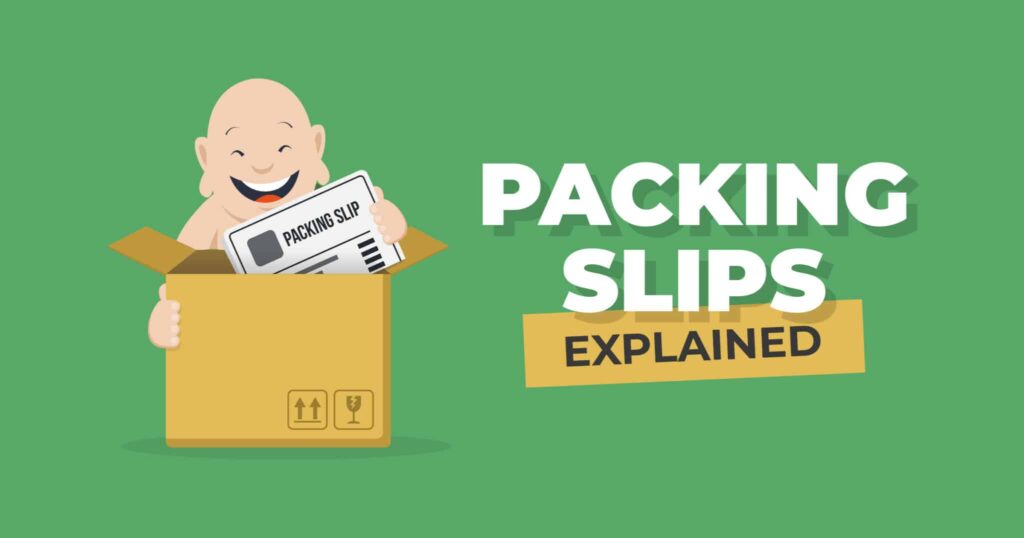So your sister’s birthday party is tonight and the presents that you paid overnight shipping for just arrived at your door. What’s more likely once you open that package — you study the packing slip in the box in great detail or you just tear through the box retrieving the items inside like a basset hound going after a bone buried in the backyard? While the packing slip may mean very little to some consumers, and perhaps is often thrown away without being looked at, it plays a pivotal role in terms of shipping logistics, inventory management, and eCommerce order fulfillment.
What is a Packing Slip?
Like a blackbox to an airplane or a recipe book to a restaurant kitchen, the packing slip found within a package is an exact account for what your shipment contains (i.e. all the crucial info). The packing slip provides necessary information related to the item(s) in your order. It lists the weights, dimensions, SKUs (Stock Keeping Units), and number of units in your shipment so that the people packing your delivery can send inventory accurately. Packing slips, therefore, are valuable to two groups of people.
- For the fulfillment center or 3PL, they provide packers with the info they need to fulfill an order correctly.
- For the consumer, they let you keep track of all items in your order, which is particularly helpful if your order is arriving in multiple shipments.
Getting Granular – Everything a Packing Slip Should Include
Exact details of a packing slip are based on the products being shipped and the eCommerce business they come from. The elements of a packing slip that remain consistent are:
- Detailed, itemized list of goods being shipped that customers can compare against the list of goods purchased, ensuring all parts of an order are accounted for. This includes the name of the items and the quantity of items in the order (possibly condensed in a quantity column so the packing slip is not pages long if many of the same item was purchased).
- Each item’s SKU or UPC (another kind of identifier/code) that eCommerce businesses use to identify their inventory and customers can reference if they need to contact a seller about an issue after delivery.
- Slip number or PO number that shippers and customers can cross-reference to make sure the right order was shipped and received.
- Customer information such as date the order was placed, the recipient’s shipping address (whether it be the person who made the purchase or another party), billing address, and contact info. If there is ever an issue with an order, this can provide the shipping carrier with backup information to complement the shipping label.
- An itemized list of any out-of-stock or backordered items that were not included in the shipment and that the customer was not previously made aware were out-of-stock or backordered.
Packing Slips Compared to Other Shipping Info
There are many important documents related to shipping. For clarification, let’s succinctly shed some light on the difference between packing slips and other pivotal paperwork related to an eCommerce order.
Packing Slip vs. Shipping Invoice
These two shipping documents are the ones most commonly mixed up; however, they serve distinct purposes. Packing slips list the physical items the customer is receiving, like a ledger or checklist. Shipping invoices are more akin to financial reports that denote the cost of the items, payment methods used for the order, payment terms, and the date the goods were sold.
In addition to the unique info these shipping documents hold, they may be intended for different audiences. The packing slip is relevant to whoever gets the package (for example the recipient of a gift you are sending) while the shipping invoice is helpful to whoever footed the bill. If the order is for you, of course, both pieces of shipping info pertain to you. Accordingly, though both shipping documents originate from the eCommerce business where you made your purchase, the invoice is generated by the payment platform you used to place the order whereas the packing slip is created by the shipping logistics technology that your fulfillment provider utilizes.
Note – all businesses use shipping invoices, but not all businesses use packing slips. For example, Amazon has started eliminating packing slips in single-box shipments to minimize packaging waste.
Packing Slip vs. Shipping Label
Here’s the main thing you need to know about the difference between packing slips and shipping labels. Packing slips are on the inside and shipping labels are on the outside. As mentioned, packing slips are mainly used as a record of the items included in your shipment for the sake of the customer and the packer at the fulfillment center. Meanwhile, a shipping label provides your shipping carriers all the info they need to deliver the order to its final destination as efficiently as possible. Shipping labels (adhered front and center to packages) include:
- Shipper address information
- Any consignee information
- Your order number
- Barcode or QR code for tracking purposes
Packing Slip vs. Bill of Lading
A lot of people have heard of shipping labels and shipping invoices. “Bill of Lading” is a less common term. This is a legal shipping document that officially transfers ownership of an order from a seller to a buyer. Although packing slips and bills of lading do have some information overlap, know that they serve dissimilar purposes. Packing slips list all products shipped in a package and included for the recipient’s sake. A bill of lading is solely for the use of the shipping courier. Typically also created and handled by the courier, a bill of lading contains the following information:
- Shipment origin
- Destination point(s)
- Carrier name
- Package weight
- Package dimension
- Value of item(s) being shipped
- Special instructions (if any)
Packing Slip vs. Delivery Note
In the Sean Connery classic Highlander, the character Kurgan dramatically declares “There can be only one!” Remember this line to recall the difference between a packing slip and a delivery note.
The delivery note is a less common shipping document. Many eCommerce brands may not include this extra kind of shipping paperwork because of the repetitive information between it and the packing slip. The delivery note lists the items that were delivered (no financial details or extra product details). However, while there can be more than one packing slip in an order, there can be only one delivery note.
More Packing Slip Ponderings
Packing Slips and Customer Experience
Every part of an eCommerce business’s packaging is a chance to make a positive, consistent impression of your brand. From the actual box to the dunnage, you can incorporate a little flare; packing slips are no exception. Add your eCommerce brand’s touch to this extra layer of the unboxing experience by implementing your logo, custom colors, etc. to the packing slip. Keep in mind though, if your packaging already has other paperwork in it (whether it be additional shipping documents or promotional inserts), don’t get carried away. You don’t want to overwhelm your customer.
Environmental Impact vs. eCommerce Tradition
We briefly mentioned earlier how Amazon is not using packing slips in single-box orders to reduce paper waste. This may not be the route for every eCommerce business, especially considering how valuable packing slip information can be to the sender and receiver. That being said, there are plenty of customers who just throw away the packing slip, so if you are an eCommerce brand looking to lighten your carbon footprint, you may consider an electronic version of a packing slip vs. the conventional kind packaged in your order at a fulfillment center.
Integration is Your Friend
There are so many steps to a successfully purchased, packaged, and delivered eCommerce order. Like in any grand endeavor, sometimes the best thing you can do to nail it is ask for help. The right help. Being your own fulfillment provider requires you (the business owner) to squander valuable entrepreneur time on many many small, extremely detailed tasks. Think about it; putting aside the sorting, picking, packing, and general inventory management, there is a ton of information to include on just one packing slip. It’s enough to overwhelm anyone, and the risk of errors is high.
If you partner with a professional fulfillment provider like ShipMonk, our wide array of diverse integrations, technology-driven custom software, and of course our state-of-the-art facilities lifts a huge weight off your shoulders in terms of time and risk. Our sophisticated systems that pair professional packers with advanced automation make every part of the packing process (from packing slip to putting a package on a truck) worry-free. After the fact, you can continue to remain calm as our software allows you to track your goods with accuracy and visibility—talk about stress-free inventory management.
Don’t Slip Up
Packing slips empower consumers to track the different items in their order, identify damaged items, estimate the value of a shipment, and confirm everything they ordered is shipped and received. On the fulfillment center side, packing slips are an itemized way for tracking the inventory that’s bound for shipping.
If your eCommerce brand utilizes packing slips, keep the above info in mind for what information to include in packing slips, how packing slips differ from other shipping documents, and extra considerations for why (and how) packing slips can matter to your eCommerce business and customers.
Most importantly, if you want to minimize the chance that your business will slip up on any packing slip details, or any packing and shipping details in general, work with a fulfillment center that has a complete handle on these processes and more.
ShipMonk retains a strong global footprint of efficient, reliable fulfillment centers. We invite you to look closer at one of these fulfillment marvels through our 360 Guided Fulfillment Center Tour, so you can see just how well taken care of your inventory will be if you trust us with your eCommerce business.





